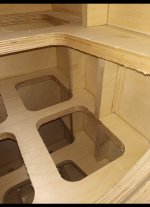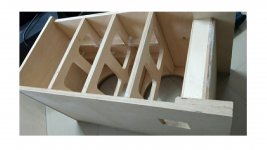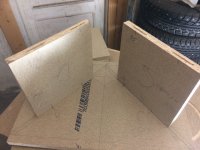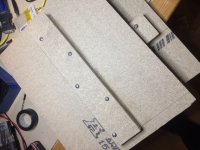Hi All,
I made a ported sub with dual 12" drivers.
(Please see the attached image)
Some people are saying that much bracing is not needed for ported sub. I used 18mm britch ply for the box, with double layers for front baffle.
1. Is it necessary for the box to be completely inert for a ported sub??
2. Does the box walls really resonate with frequencies below 100Hz??
3. If I knock on the box it sounds different, with and without bracing. So the bass also sounds different with and without bracing ???
4. Assuming the port is tuned properly to have a flat responce, and smooth rolloff, does the bracing help further for clean bass??
Any suggestions will help a lot !!!
Thanks in advance...
I made a ported sub with dual 12" drivers.
(Please see the attached image)
Some people are saying that much bracing is not needed for ported sub. I used 18mm britch ply for the box, with double layers for front baffle.
1. Is it necessary for the box to be completely inert for a ported sub??
2. Does the box walls really resonate with frequencies below 100Hz??
3. If I knock on the box it sounds different, with and without bracing. So the bass also sounds different with and without bracing ???
4. Assuming the port is tuned properly to have a flat responce, and smooth rolloff, does the bracing help further for clean bass??
Any suggestions will help a lot !!!
Thanks in advance...
Attachments
Last edited:
With sub woofers, easiest way to deal with cabinet resonance is to stiffen the enclosure with bracing so that the enclosure resonances go up in frequency, high enough not to be in the sub woofers pass band and thus out of mind. So 1) no.
2) Maybe, walls resonate on some frequencies. Stiff bracing doesn't eliminate cabinet resonance, makes a resonance higher in frequency dividing panels into smaller surface areas. Dampening would reduce resonance in level.
3) You'd have to build two identical boxes, one with and one without bracing and arrange a blind listening test with help of a friend switching between the subs to determine if there is audible difference.
4) Yes if it makes audible cabinet resonances not audible 🙂
Too much bracing is just more work and more weight. More weight can benefit, if the woofer wants to walk. Cheaper and easier to build solution would be to put the two woofers on opposing sides of the enclosure and let them cancel out even more cabinet vibration, if aesthetics allow. Less mass and bracing needed this way I think.
There is tons of info on the forum and on the web if you search. My terminology might contain errors. In general, add some bracing, no need to go overboard with subwoofers. If two speaker elements, but them on opposing sides.
2) Maybe, walls resonate on some frequencies. Stiff bracing doesn't eliminate cabinet resonance, makes a resonance higher in frequency dividing panels into smaller surface areas. Dampening would reduce resonance in level.
3) You'd have to build two identical boxes, one with and one without bracing and arrange a blind listening test with help of a friend switching between the subs to determine if there is audible difference.
4) Yes if it makes audible cabinet resonances not audible 🙂
Too much bracing is just more work and more weight. More weight can benefit, if the woofer wants to walk. Cheaper and easier to build solution would be to put the two woofers on opposing sides of the enclosure and let them cancel out even more cabinet vibration, if aesthetics allow. Less mass and bracing needed this way I think.
There is tons of info on the forum and on the web if you search. My terminology might contain errors. In general, add some bracing, no need to go overboard with subwoofers. If two speaker elements, but them on opposing sides.
Last edited:
Thanks a lot for all the inputs !!!
I thought of putting the drivers on opposite faces, but i love the looks with both drivers on same face.
I thought of putting the drivers on opposite faces, but i love the looks with both drivers on same face.
Diagonal braces, (preferably glued with elastic glue,) will be more efficient in stopping plate resonances, since triangular plate sections have no natural resonances.
Johan-Kr
Johan-Kr
Attachments
Last edited:
A subwoofer typically works below 100Hz, very long wavelengths. Inside the box there will be pressure variation, but also air motion because of the port. Port leaks most of the soundpressure out below and at tuning frequency, then gradually less as we can see in (sound pressure level) response graphics.
Long wavelengths can't make standing waves inside, but pressure makes the box to expand and contract (ballooning), and this motion creates also resonances with harmonic overtones (distortion) Internal braces effectively prevent ballooning (attenuates) and move resonances to higher freq. The ballooning/resonating box also resonates with the floor easily.
Box wall resonances can be measured with accelometers and to some poor quality with normal audio mic places very close to sufrace. Measurements should be taken from many spots. You can use your hand to feel the worst spots too.
Resonaces make distortion peaks in "normal" measurements. Problem is that these bass freq measurement should be don outdoors to eliminate room standing waves and structural resonances of walls and furniture!
My sealed 235 liter boxes had some braces too... A bench style cabinet subwoofer 2x15 closed
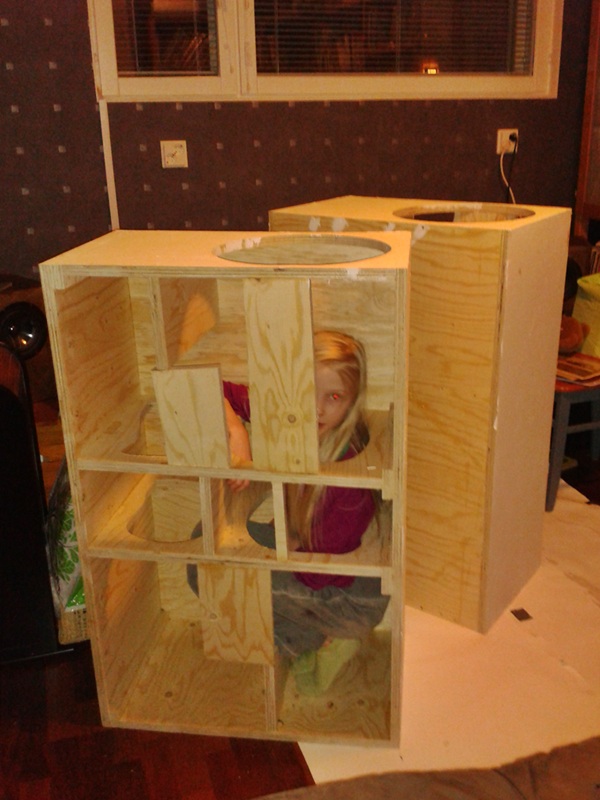
Long wavelengths can't make standing waves inside, but pressure makes the box to expand and contract (ballooning), and this motion creates also resonances with harmonic overtones (distortion) Internal braces effectively prevent ballooning (attenuates) and move resonances to higher freq. The ballooning/resonating box also resonates with the floor easily.
Box wall resonances can be measured with accelometers and to some poor quality with normal audio mic places very close to sufrace. Measurements should be taken from many spots. You can use your hand to feel the worst spots too.
Resonaces make distortion peaks in "normal" measurements. Problem is that these bass freq measurement should be don outdoors to eliminate room standing waves and structural resonances of walls and furniture!
My sealed 235 liter boxes had some braces too... A bench style cabinet subwoofer 2x15 closed
I did not notice the small person inside your cabinet at first, and they gave me quite a scare when I recognized them as human. Please tell me you’ll check to ensure they aren’t sealed in with the woofer. 🙂
Looks to me like you've added enough bracing for two 12s, unless you have ridiculously high output drivers.
My sub has far less, and has no issues, although it had two 10s, but with 1 inch mdf.
You cant add too much bracing, so long as you can live with the weight, loss of internal volume, and don't totally over do it causing obstructions especially around the port
My sub has far less, and has no issues, although it had two 10s, but with 1 inch mdf.
You cant add too much bracing, so long as you can live with the weight, loss of internal volume, and don't totally over do it causing obstructions especially around the port
I left enough open space near the port. And bracing also helped in adding weight. Britch ply is slightly light weight compared to other plywoods.
You'll want a separate bisquit joner, not a router for fixing this.I planned to use them.....but i don't have a router yet. Il get one soon... !!
If you go on youtube and have a look at the how-tos, you'll notice that the joiner has a special bottom plate that enables you to make accurate placements of the slots.
From my experience, you don't really need to get a very high-end machine for this. I bought a cheap ($75) machine at Jula (a low-price chain selling all sorts of stuff), and I managed to assemble the box with 3 internal braces going in different directions, as well as the outher plates with only bisquits and glue. I didn't even have to resort to excessive violence (aka an adjustment sledgehammer) 😀
Johan-Kr
- Home
- Loudspeakers
- Subwoofers
- Some people are saying I added too much bracing. How much is really needed ??
